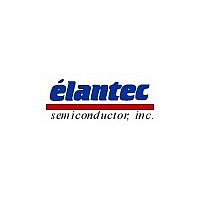EL2252CN Elantec Inc, EL2252CN Datasheet

EL2252CN
Available stocks
Related parts for EL2252CN
EL2252CN Summary of contents
Page 1
... Applications Pin receiver for automatic test equipment Data communications line receiver Frequency counter input Pulse squarer Ordering Information Part No Temp Range Package Outline EL2252CN 14-Pin P-DIP MDP0031 a EL2252CM 20-Lead SOL MDP0027 a Note All information contained in this data sheet has been carefully checked and is believed to be accurate as of the date of publication however this data sheet cannot be a ‘‘controlled document’’ Current revisions if any to these ...
Page 2
EL2252C Dual 50 MHz Comparator Pin Receiver Absolute Maximum Ratings Voltage between V and Voltage Voltage between IN and IN pins b a Output Current Current into IN IN HYS TTL ...
Page 3
Dual 50 MHz Comparator Pin Receiver DC Electrical Characteristics V 15V HYS and TTL grounded unless otherwise specified Parameter Description CMRR Common-Mode Rejection Ratio (Note 1) PSRR Power-Supply Rejection Ratio (Note 2) ...
Page 4
EL2252C Dual 50 MHz Comparator Pin Receiver AC Test Circuit Burn-In Circuit 2252 – 2252 – 3 ...
Page 5
Typical Performance Curves Input Bias Current vs Small Overdrives Bias Current vs Temperature Inputs Balanced Input Output Transfer Function HYS Open Dual 50 MHz Comparator Pin Receiver Input Bias Current vs Large Overdrives Input Hysteresis Voltage vs Temperature Input Output ...
Page 6
EL2252C Dual 50 MHz Comparator Pin Receiver Typical Performance Curves Supply Current vs Supply Voltage Output Delay 0 5V Overdrive Output with 50 MHz CMOS Input Contd Supply Current vs Temperature (V 15V Output Delay 0 5V ...
Page 7
Typical Performance Curves Gain vs Frequency Propagation Delay vs Overdrive CMOS Input Dual 50 MHz Comparator Pin Receiver Contd 4 ns TTL Glitch Detection Propagation Delay vs Temperature CMOS Input Propagation Delay vs Input Slew Rate CMOS Input 7 EL2252C ...
Page 8
EL2252C Dual 50 MHz Comparator Pin Receiver Typical Performance Curves Propagation Delay vs Power Supply Voltage 14-Lead Plastic DIP Maximum Power Dissipation vs Ambient Temperature Contd Propagation Delay vs Load Capacitance 20-Lead SOL Maximum Power Dissipation vs Ambient Temperature 2252 ...
Page 9
Simplified Schematic Applications Information The EL2252 is very easy to use and is relatively oscillation-free but a few items must be attend- ed The first is that both supplies should be by- passed closely 1 F tantalums are very good ...
Page 10
EL2252C Dual 50 MHz Comparator Pin Receiver Applications Information One of the few ways in which oscillations can be induced is by connecting a high-Q reactive source impedance to the EL2252 inputs Such sources are long wires and unterminated coaxial ...
Page 11
Dual 50 MHz Comparator Pin Receiver EL2252C Macromodel Connections input a l input HYS ...
Page 12
... General Disclaimer Specifications contained in this data sheet are in effect as of the publication date shown Elantec Inc reserves the right to make changes in the circuitry or specifications contained herein at any time without notice Elantec Inc assumes no responsibility for the use of any circuits described herein and makes no representations that they are free from patent infringement ...












